GLYPHOSATE - THE FALLOW TOOL WE CAN?T AFFORD TO LOSE
| Date: 16 Sep 2009
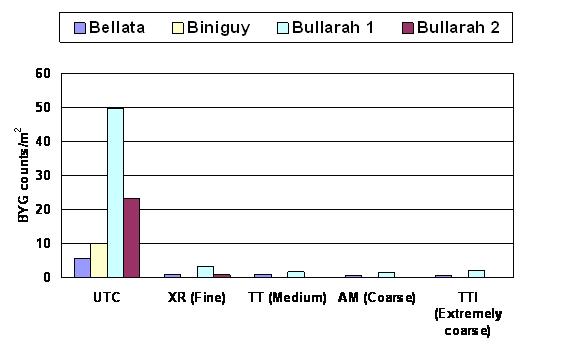
GRDC code
NGA00001: validation and integration of new technology through grower groups in north-west NSW and south-west Queensland grain growing zones
NGA00002: validation and integration of new technology through grower groups in north-east NSW grain growing zones
Background
Glyphosate has long been our critical herbicide in enabling effective and economic fallow weed control in stubble conservation farming systems. However the long period, and often high intensity, of glyphosate use has now pushed us to the brink of widespread glyphosate resistance issues. Growers and advisers alike have recognised the pressing need to develop alternative fallow strategies to help ensure glyphosate remains a viable component of fallow management.
The approach
NGA has been involved in summer fallow herbicide evaluation trials in both the 2007/08 and 2008/09 seasons. We have looked at two simple approaches which may help reduce the pressure on glyphosate resistance selection:
1. Is there more opportunity to use existing residual chemistry in summer fallows? (and if so, are there simple tools to improve consistency of performance)
2. How effective is a double-knock approach, on specific weeds, and what are the key issues to ensure maximum efficacy?
1. The fit of residual herbicides in the summer fallow
Summer 2007/08 – Flame® application parameters
Barnyard grass generally has multiple germinations (or cohorts) and as a consequence is a weed that often requires multiple fallow sprays. In 2007/08 NGA looked at simple application parameters and their impact on the level of barnyard grass control achieved with Flame (active ingredient imazapic). Flame is a product that can provide very effective residual control of a range of grasses and broadleaf weeds, however variability in performance has often been an issue.
Four trials were conducted with Flame at 0.2 L/ha applied at three water application volumes (50, 75 and 100 L/ha) and four droplet sizes (fine, medium, coarse, extremely coarse). This was achieved using XR, TT, AM and TTi 110015 nozzles. All combinations of volume and droplet size were evaluated, with all trials commencing during November 2007 and sprayed following a fallow spray or to bare dry soil. Figures 1 and 2 below show the surviving weed counts, taken 8-12 weeks after application where UTC = untreated control.
Figure 1. Barnyard grass counts by nozzle/droplet size (mean of all 3 water volumes)
Figure 2. Barnyard grass counts by water volume (mean of all 4 nozzles) 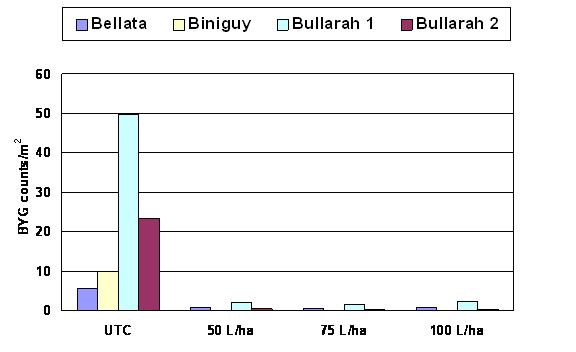
Key points
1. Nozzle type/ droplet size had NO impact on level of control
2. Application volume had NO impact on level of control
3. Greater than 95% control was obtained at 3 of the 4 sites
4. Application PRIOR to weed germination appeared to be more important than application parameters
Summer 2008/09 – Residual herbicide screen
In 2008/09 NGA have established four residual herbicide sites. All trials received the same 14 treatments, evaluating combinations of eight different herbicides. Although barnyard grass is still a priority, the screening is to examine chemistry that may allow broad spectrum residual control. The data below is from a site near Goondiwindi showing residual barnyard grass control (the most abundant weed). All products were applied at 70 L/ha with AIXR110015 nozzles. NB Not all products have a specific summer fallow registration for barnyard grass control so the advice is to read and follow the product label in all situations.
Figure 3. Barnyard grass counts Goondiwindi 2008/09 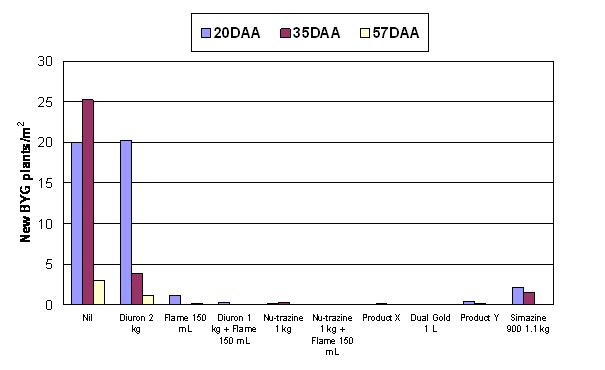
DAA = days after application
NB knockdown sprays applied after both 20 and 35 day assessment.
The data above is preliminary but indicates good levels of residual control were achieved with a range of herbicides for at least 35 days after application. NB This is only 1 trial and conducted under conditions where good rainfall occurred shortly after treatment application on 13th Nov 2008 with follow up over next 8 weeks requiring three fallow sprays.
Figure 4. Stink grass counts Gilgandra 2008/09 (36 DAA) 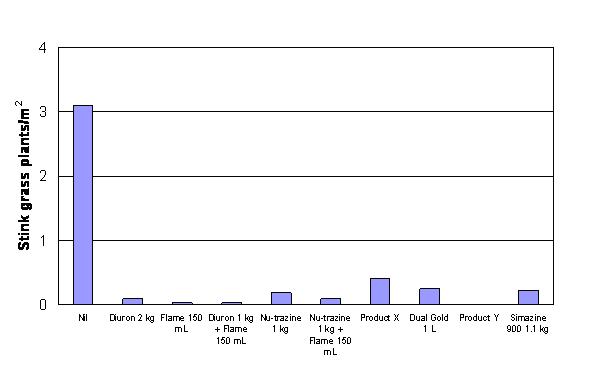
All herbicides provided significant control of stink grass at the first assessment.
NB The 2008/09 residual screening trials are being monitored throughout the summer fallow. Although useful levels of control of two grass species has been identified early in the fallow, long term residual performance and weed spectrum will be of critical importance for these approaches to have practical and economic value.
Other considerations
Residuals could be very useful in reducing the selection pressure on glyphosate but their cost, other weed spectrum and plant back profile must be considered. Although Flame was originally positioned as an option immediately following the harvest of a winter crop, the plant back period to a following summer crop may be of concern. Use of Flame after winter crop harvest also means summer growing weeds are likely to have already commenced germination particularly in years of wetter harvests. An alternative position may be to use the herbicide during the long fallow following a summer crop when application can occur early in the spring prior to the first flushes of summer weeds. This may improve weed control but also allow a longer period for the residual to breakdown before the following winter crop. NB Not all products have a specific summer fallow registration for control of stink grass so the advice is to read and follow the product label in all situations.
2. Double-knock efficacy on barnyard grass
The focus in 2007/08 was to generate more confidence in the length of time between the two herbicide applications. In addition we evaluated rate responses to the second herbicide (Table 1).
Four trials were conducted in barnyard grass populations expected to be glyphosate susceptible. Roundup® CT (glyphosate 450g/L a.i.) was applied at 0.5 L/ha in all trials, at a sub-lethal below label rate, to simulate a situation where resistance to glyphosate was developing. Nuquat® (paraquat 250g/L a.i.) was applied at 1.6 L/ha as a stand alone in comparison to Roundup CT and then as the second knock in all trials. All treatments were applied at a water rate of ~75 L/ha with medium to coarse droplets.
Table 1. Trial locations and key details
|
Location
|
Final Barnyard grass counts/m2
|
Double knock interval (days)
|
Barnyard grass growth stages
Timing 1 Timing 2 Timing 3 Timing 4
|
|||
|
Biniguy NSW
|
217
|
1, 5 or 10
|
2-6 leaf
|
2-6 leaf
|
4-7 leaf
|
6-8 leaf
|
|
Milguy NSW
|
438
|
1, 5 or 10
|
2-6 leaf
|
2-6 leaf
|
3-7 leaf
|
4-8 leaf
|
|
Pittsworth QLD
|
59
|
1, 5 or 10
|
Early-mid tillering
|
Early-mid tillering
|
Mid-late tillering
|
Late tillering-seed set
|
|
Bullarah NSW
|
79
|
1, 4 or 10
|
4 leaf
|
4 leaf
|
Early tillering
|
Mid tillering
|
Figure 5 shows the surviving weed counts, taken ~ 3 weeks after the first application.
Figure 5. Final barnyard grass counts (20-21DAA1) 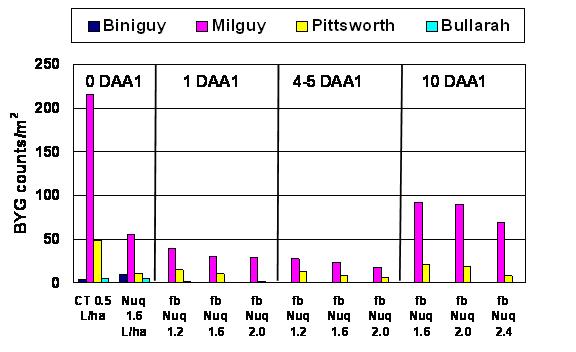
1 DAA1 = Second herbicide applied 1 day after initial application
fb = Roundup CT 0.5 L/ha followed by Nuquat rate and timing as specified
Key points
1. All double knock treatments provided better control than Roundup CT alone
2. Double knock treatments generally provided better control than Nuquat alone
3. 4-5 day delay provided most consistent control closely followed by 1 day delay. Possible that the 4-5 day delay applications may have controlled new weeds that emerged after the 1 day application was applied
4. 10 day delay effective at some sites but poor, as expected, when used on larger or stressed weeds
5. Dose response to Nuquat with 1.6 and 2 L/ha rate generally more robust than 1.2 L/ha
6. Not even double knock treatments gave complete barnyard grass control under very high weed burdens (Milguy) or on larger and stressed plants (Pittsworth). Critical to go in early and hard.
So where does double-knock fit ?
Obviously double knock approaches will result in increased herbicide cost together with increased labour and application costs. However the alternative is to just keep on using glyphosate for every fallow spray which will only end up in tears for all. Double knock is not an approach to consider, at least for economic reasons, for multiple germinations in the one paddock in the one season but there are a number of situations where it should be considered:
1. In individual paddocks where glyphosate alone has been the primary barnyard grass management approach over many years.
2. One application per season in the paddock with the highest barnyard grass population.
3. On the first or second barnyard grass emergence flush in the spring/summer when the weed numbers are likely to be at their highest.
Other considerations
The primary focus of any weed management is to achieve a very high level of control and minimize (or if possible eliminate) any seed bank replenishment. Desiccants such as paraquat and paraquat plus diquat are not very effective on larger weeds. To ensure high levels of control it is critical that the glyphosate is applied to young weed stages and the desiccant is applied before weeds are too large or stressed. This requires close attention to timing particularly in paddocks with varying soil types.
Acknowledgements
Thanks to the many growers and consultants involved in this trial work, the contractors involved and Clare Felton-Taylor and Anthony Mitchell for field co-ordination.
Contact details
Richard Daniel & Lawrie Price
Northern Grower Alliance
Ph: 07 4639 5344
Emails: richard.daniel@nga.org.au or lawrie.price@nga.org.au
® Registered trademark
Was this page helpful?
YOUR FEEDBACK
